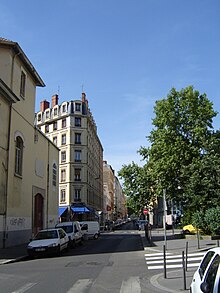Rue Vendôme
| Rue Vendôme | |
|---|---|
| location | |
| country | France |
| region | Rhône-Alpes |
| city | Lyon |
| District | 6th and 3rd arrondissement |
| morphology | |
| Type | Street |
| history | |
| former name | Avenue de Vendôme (Sud) Avenue de Grammont (North) Coordinates: 45 ° 46 ′ N , 4 ° 51 ′ E |
The Rue Vendome is a street in the 6th and 3rd arrondissement of Lyon . It leads from the Avenue de Grande Bretagne (6th arrondissement) along the Rhône to the Cours Gambetta (3rd arrondissement), where it crosses the Place Guichard .
history
The street was laid out at the beginning of the 19th century and embedded in the checkerboard pattern designed by Jean-Antoine Morand for Brotteaux in the 18th century; it was opened in 1835. Until 1855 the first part of the street (to the north of the Cours Franklin Roosevelt, then still Cours Morand) was called Rue de Grammond, in honor of Luc Urbain du Bouëxic de Guichen . It was renamed Rue des Martyrs because people were murdered there during the events of 1793. In 1939 part of the street became Rue Jean-Marie Chavant.
The northern part of the street was designed at the end of the 18th century by the architect Jean-Antoine Morand and completed in 1848, then extended south in 1857 under the prefect Claude-Marius Vaïsse . Several houses in the street were built by the following architects: Journoud, Lablatinière, Prosper Bissuel and Felix Bellemain. In 1881 the great organ builder, Merklin et Cie, settled in house number 11. The draftsman Pierre-Marie Mortamais also lived in the street in 1895.
Special facilities
Various associations have their headquarters in the street:
- A Seventh-day Adventist Church
- Consulates of Sweden, Malta and Italy
- Food & Furnishing Shops (Furniture)
- schools
- Restaurants
- A library for family and genealogy research
- A Center for Alcoholics Anonymous
- Doctors 'offices and lawyers' offices
architecture
The street begins with row houses, then narrows to the Puvis square and then ends with three one-story and some middle-class houses from the 19th century. After the Church of the Redeemer there are some five-story houses from the 19th century with richly decorated and wrought-iron balconies. After the Rue de Sèze, the street becomes very wide, bordered by trees and the facades of the buildings are decorated with sculptures. After that, the architecture becomes simpler again with houses from all eras. One house is covered with reddish bricks. An iron harp can be seen on the balcony of house no. 280.
Individual evidence
- ↑ Jean Pelletier, Connaître son arrondissement: le 3e. De la Guillotière à la Part-Dieu, de Montchat à Monplaisir , Éditions lyonnaises d'art et d'histoire, 2000, ISBN 2-84147-076-8
- ↑ a b Maurice Vanario, Rues de Lyon à travers les siècles, Lyon , ELAH, 2002, ISBN 2-84147-126-8 , p 305
- ↑ a b Jean Pelletier, Lyon pas à pas - son histoire à travers ses rues - Presqu'île, rive gauche du Rhône, quais et ponts du Rhône , Ed. Horvath, Roanne / Le Coteau, 1986, p. 104, ISBN 2 -7171-0453-4
- ^ Robert Brun De La Valette, Lyon et ses rues , Paris, Le Fleuve, 1969, p. 257
- ↑ Louis Meynard, Dictionnaire des lyonnaiseries - Les hommes. Le sol. Les rues. Histoires et légends , Vol. 4, Lyon, Jean Honoré, 1932, p. 152
- ↑ Further information in French at: Rues de Lyon
